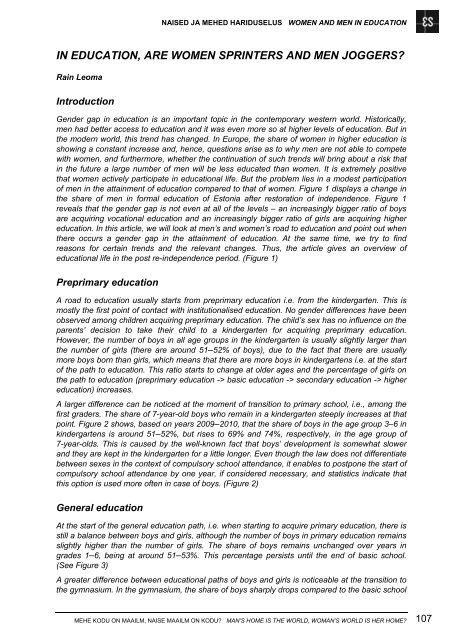MEHE KODU ON MAAILM, NAISE MAAILM ON KODU? - Tartu Ãlikool
MEHE KODU ON MAAILM, NAISE MAAILM ON KODU? - Tartu Ãlikool
MEHE KODU ON MAAILM, NAISE MAAILM ON KODU? - Tartu Ãlikool
You also want an ePaper? Increase the reach of your titles
YUMPU automatically turns print PDFs into web optimized ePapers that Google loves.
<strong>NAISE</strong>D JA <strong>MEHE</strong>D HARIDUSELUS WOMEN AND MEN IN EDUCATI<strong>ON</strong><br />
IN EDUCATI<strong>ON</strong>, ARE WOMEN SPRINTERS AND MEN JOGGERS?<br />
Rain Leoma<br />
Introduction<br />
Gender gap in education is an important topic in the contemporary western world. Historically,<br />
men had better access to education and it was even more so at higher levels of education. But in<br />
the modern world, this trend has changed. In Europe, the share of women in higher education is<br />
showing a constant increase and, hence, questions arise as to why men are not able to compete<br />
with women, and furthermore, whether the continuation of such trends will bring about a risk that<br />
in the future a large number of men will be less educated than women. It is extremely positive<br />
that women actively participate in educational life. But the problem lies in a modest participation<br />
of men in the attainment of education compared to that of women. Figure 1 displays a change in<br />
the share of men in formal education of Estonia after restoration of independence. Figure 1<br />
reveals that the gender gap is not even at all of the levels – an increasingly bigger ratio of boys<br />
are acquiring vocational education and an increasingly bigger ratio of girls are acquiring higher<br />
education. In this article, we will look at men’s and women’s road to education and point out when<br />
there occurs a gender gap in the attainment of education. At the same time, we try to find<br />
reasons for certain trends and the relevant changes. Thus, the article gives an overview of<br />
educational life in the post re-independence period. (Figure 1)<br />
Preprimary education<br />
A road to education usually starts from preprimary education i.e. from the kindergarten. This is<br />
mostly the first point of contact with institutionalised education. No gender differences have been<br />
observed among children acquiring preprimary education. The child’s sex has no influence on the<br />
parents’ decision to take their child to a kindergarten for acquiring preprimary education.<br />
However, the number of boys in all age groups in the kindergarten is usually slightly larger than<br />
the number of girls (there are around 51–52% of boys), due to the fact that there are usually<br />
more boys born than girls, which means that there are more boys in kindergartens i.e. at the start<br />
of the path to education. This ratio starts to change at older ages and the percentage of girls on<br />
the path to education (preprimary education -> basic education -> secondary education -> higher<br />
education) increases.<br />
A larger difference can be noticed at the moment of transition to primary school, i.e., among the<br />
first graders. The share of 7-year-old boys who remain in a kindergarten steeply increases at that<br />
point. Figure 2 shows, based on years 2009–2010, that the share of boys in the age group 3–6 in<br />
kindergartens is around 51–52%, but rises to 69% and 74%, respectively, in the age group of<br />
7-year-olds. This is caused by the well-known fact that boys’ development is somewhat slower<br />
and they are kept in the kindergarten for a little longer. Even though the law does not differentiate<br />
between sexes in the context of compulsory school attendance, it enables to postpone the start of<br />
compulsory school attendance by one year, if considered necessary, and statistics indicate that<br />
this option is used more often in case of boys. (Figure 2)<br />
General education<br />
At the start of the general education path, i.e. when starting to acquire primary education, there is<br />
still a balance between boys and girls, although the number of boys in primary education remains<br />
slightly higher than the number of girls. The share of boys remains unchanged over years in<br />
grades 1–6, being at around 51–53%. This percentage persists until the end of basic school.<br />
(See Figure 3)<br />
A greater difference between educational paths of boys and girls is noticeable at the transition to<br />
the gymnasium. In the gymnasium, the share of boys sharply drops compared to the basic school<br />
<strong>MEHE</strong> <strong>KODU</strong> <strong>ON</strong> <strong>MAAILM</strong>, <strong>NAISE</strong> <strong>MAAILM</strong> <strong>ON</strong> <strong>KODU</strong>? MAN’S HOME IS THE WORLD, WOMAN’S WORLD IS HER HOME? 107

















